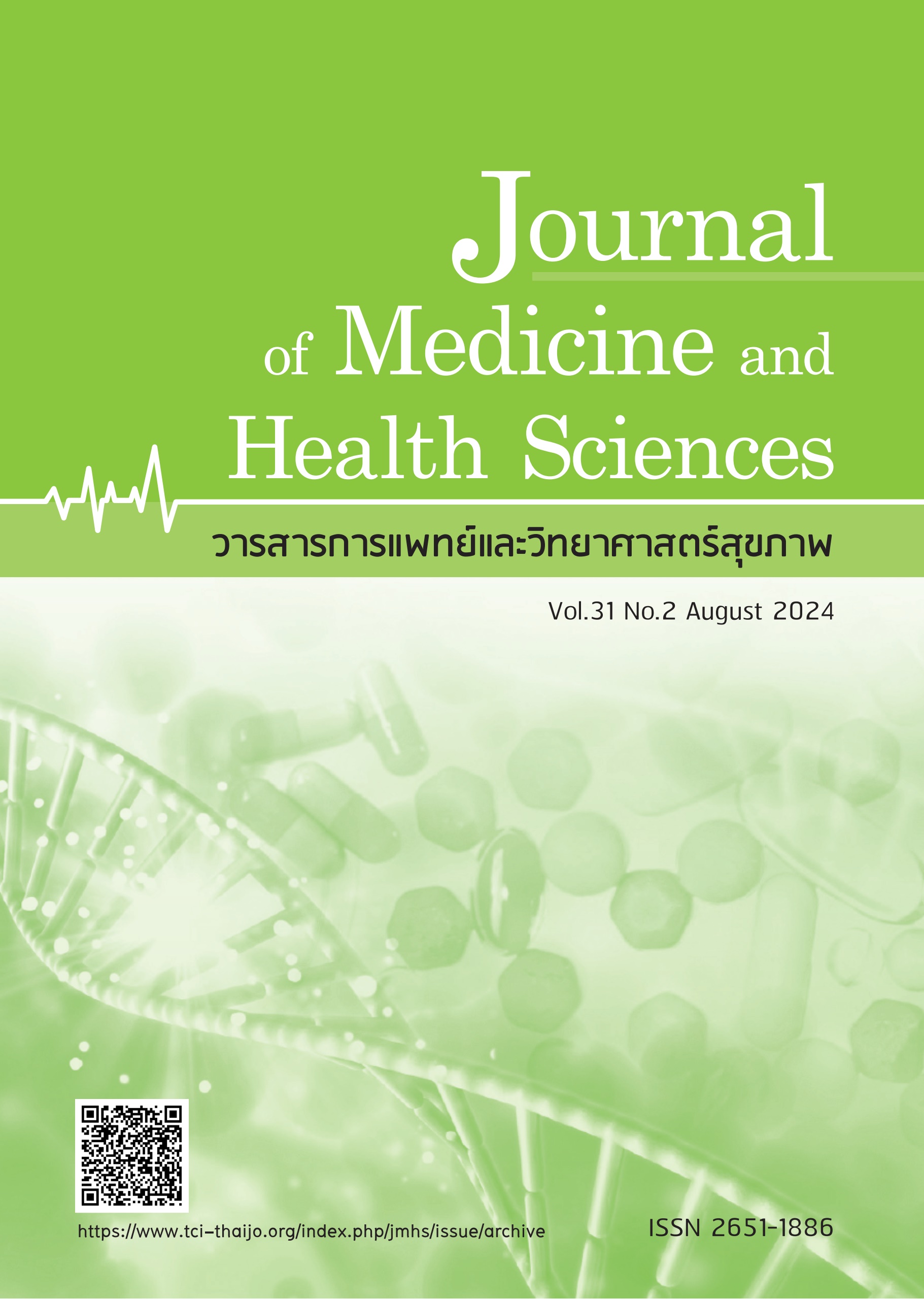The Antioxidant and biological activity of Dillenia parviflora Griff. Fruits
Keywords:
Dillenia parviflora Griff, Antioxidant activity, elastase, tyrosinase, hyaluronicAbstract
This study aimed to evaluate the antioxidant and biological activities of Dillenia parviflora Griff. (Dp) extract through various analyses, including determination of total phenolic content, DPPH radical scavenging assay for antioxidant activity, and inhibition of elastase, tyrosinase, and hyaluronidase enzymes. The study also assessed the inhibition of nitric oxide production in lipopolysaccharide (LPS)-stimulated macrophage (RAW 264.7) cells and evaluated the wound healing efficacy in human keratinocyte (HaCaT) cells. The results showed that the average total phenolic content in Dp was 28.14±0.97 mg GAE/g. Dp exhibited significantly lower compared to vitamin C (p = 0.019). A concentration 1 mg/mL of Dp demonstrated anti-inflammatory effects in RAW 264.7 cells, which were significantly less potent than triamcinolone acetonide (p = 0.003). It has an inhibitory effect on tyrosinase IC50 >1000 (mg/ml) less than vitamin C. Dp also showed slight inhibition of elastase activities, with the latter being significantly weaker than that of EGCG (p = 0.016). However, Dp did not inhibit hyaluronidase activity. The wound healing assay indicated that 1 mg/mL Dp could stimulate human skin cell migration faster than the control but slower than vitamin C (p = 0.49). Future studies should focus on identifying the active compounds responsible for these effects and conducting clinical trials to explore the potential application to herbal innovations.
References
Sabandar CW, Jalil J, Ahmat N, et al. Medicinal uses, chemistry and pharmacology of Dillenia species (Dilleniaceae). Phytochemistry 2017;134:6-25. doi: 10.1016/j.phytochem.2016.11.010
Lima, C.C., Lemos, R.P., Conserva, L.M. Dilleniaceae family: an overview of its ethnomedicinal uses, 3 biological and phytochemical profile. J Pharmacogn Phytochem 2014;3:181-204.
Saiful Yazan L, Armania N. Dillenia species: A review of the traditional uses, active constituents and pharmacological properties from pre-clinical studies. Pharm Biol 2014;52:890-7. doi: 10.3109/13880209.2013.872672
Goh, M.P., Ahmad, N., Yasin, H.M, et al. Antioxidant, antibacterial and cytotoxic activity of the Dillenia suffruticosa Leaves against the Lung (A549) and Cervical (CaSki) Cancer Cell Lines. The Natural Products Journal 2021;(11).DOI:10.2174/2210315511666210204120431
Yakop, F., Sheikh Abdul Hamid, M.H., Ahmad, N, et al. Phytochemical screening, antioxidant and antibacterial activities of extracts and fractions of Dillenia suffruticosa leaves. Malaysian Applied Biology 2020;https://doi.org/10.55230/mabjournal.v49i1.1663
Sabandar, C.W., Jalil, J., Ahmat, N, et al. Antioxidant activity and inhibition of xanthine oxidase of songi bark (Dillenia serrata Thunb.). Jurnal Farmasi Galenika (Galenika Journal of Pharmacy) 2020;https://doi.org/10.22487/j24428744.2020.v6.i1.15008
Biju J., Sulaiman C.T., Satheesh G, et al. Total phenolic and flavonoids in selected medical plants from kerala. Int J Pharm Pharm Sci 2014;6:406-8.
Mongkolsilp S., Pongbupakit I., Sae-Lee N, et al. Radical scavenging activity and total phenolic content of medicinal plants used in primary health care. SWU J Pharm Sci 2004;9:32-5.
Manosroi A, Ruksiriwanich W, Abe M, et al. Biological activities of the rice bran extract and physical characteristics of its entrapment in niosomes by supercritical carbon dioxide fluid. J Supercrit Fluids 2010;54:137-44.
Manosroi, A., Boonpisuttinant, K., Winitchai, S, et al. Free radical scavenging and tyrosinase inhibition activity of physic nut (Jatropha curcas Linn.) seed oil entrapped in niosomes. Current Nanoscience 2011;7:825-9.
Chang, T.S. An updated review of tyrosinase inhibitors. Int J Mol Sci 2009;10:2440-75.
Lee S-H, Sanchetis., Sancheti S, et al. Potent antielastase and antityrosinase activities of Astilbe chinensis. Am J Pharmacol Toxicol 2009;4:127-9.
Kim S.J., Sancheti S.A., Sacncheti S, et al. Effect of 1,2,3,4,6-penta-o-galloyl--d-glucose on elastase and hyaluronidase activities and its type II collagen expression. Acta Pol Pharm 2010;67:145-50.
Manosroi A, Kumguan K, Chankhampan C, et al. Nanoscale gelatinase A (MMP-2) inhibition on human skin fibroblasts of Longkong (Lansium domesticum Correa) leaf extracts for anti-aging. J Nanosci Nanotechnol 2012;12:7187-97.
ISO 10993-5: 2009 Biological Evaluation of Medical Devices. Part 5: Tests for In vitro cytotoxicity. International Organization for Standardization; Geneva, Switzerland: 2009.
Sutthiwanjampa C. and Kim S.M. Production and characterization of hyaluronidase and elastase inhibitory protein hydrolysate from venus clam. Nat Prod Res 2015;29:1614–23
Insaf, A., Parveen, R., Gautam, G, et al. A comprehensive study to explore tyrosinase inhibitory medicinal plants and respective phytochemicals for hyperpigmentation; molecular approach and future perspectives. Curr Pharm Biotechnol 2023;24:780-813.
Torres-Rodríguez M.T., García-Chávez E., Berhow M. Anti-inflammatory and anti-oxidant effect of calea urticifolia lyophilized aqueous extract on lipopolysaccharide-stimulated raw 264.7 macrophages. J Ethnopharmacol 2016;188:266-74.
Muhammad, AA., Pauzi, NAS., Arulselvan, P. In vitro wound healing potential and identification of bioactive compounds from Moringa oleifera Lam. Biomed Res Int 2013;2013:974580. doi: 10.1155/2013/974580
Vichai, V., Kirtikara, K. Sulforhodamine B colorimetric assay for cytotoxicity screening. Nat Protoc 2006;1(3):1112-6. doi: 10.1038/nprot.2006.179.
Downloads
Published
How to Cite
Issue
Section
License
Copyright (c) 2024 Journal of Medicine and Health Sciences

This work is licensed under a Creative Commons Attribution-NonCommercial-NoDerivatives 4.0 International License.



